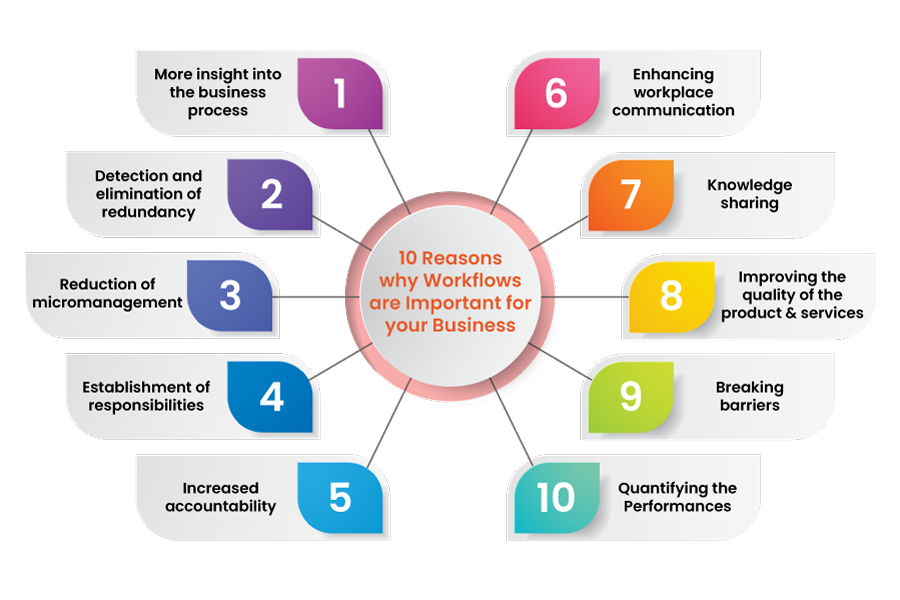
The concept of Workflows might be perplexing or new for some, but it’s not! Workflows can be traced back to the Prehistoric Era when humans had to hunt for their survival and get things done. They were unaware of the word “Workflow” but followed the concept. It wasn’t until the 20th century (progressive era), when the “Taylorism Theory” by an American Mechanical Engineer, Frederick Winslow Taylor (1856-1915), came into existence that he stressed upon analysis and optimization of workflow to increase the productivity of the industries.
Why is Workflow Important?
A Workflow is an iterative process consisting of a series of sequential tasks/activities through which the designated work passes from start to finish regularly. Workflow is not only about completing the work, but that work should be done in the most efficient, fastest, and satisfying way possible. Technology is everywhere, and it has automated workflow concepts as well. Workflow automation has revolutionized modern businesses, where every work activity is now divided into distinct tasks, rules, procedures, and roles. Using our automation maturity assessment guide, you can employ thought-provoking questions to ascertain if your processes can be automated.
Workflows do not eliminate humans from work, but they help remove human errors from the work! It is all about efficiency, quality, and consistency.
Also read: 5 No-Code Ways to Upgrade Automated Workflows
Importance of Workflow

1. More insight into the business process
For greater insights, workflows prove to be beneficial. Attaining a favorable outcome is the utmost important goal for an organization. It gives regular insights into what is happening within the process and the people involved in achieving that goal. By mapping the business workflows, one can understand how the data flows through the organizational system and impacts its decisions and work. It gives a clear, concise, and top-level view of the business.
2. Detection and elimination of redundancy
Redundancy is a serious threat to business processes. On a daily basis, a business deals with lots of unnecessary and redundant tasks in a day, which can result in a waste of time and resources. Detecting and eliminating redundant tasks is a crucial step for any business organization, as it lets the employees focus on genuinely significant activities and create value for the business. After yielding insights about the processes during the workflow, one can analyze all the activities and can eliminate the redundant and unnecessary ones.
3. Reduction of micromanagement
Micromanagement is, more often than not, considered a negative connotation that denotes a lack of freedom at the workplace. It leads to a toxic work environment, diminished performance, and increased employee turnover. When the workflow process is correctly mapped, managers will automatically invest less time in micromanaging their employees. Reduced micromanaging will therefore result in increased productivity and improved manager-employee relationships!

4. Establishment of responsibilities
To achieve success, an organization must motivate and encourage its employees in all the best ways possible. The best way to do so is by giving them full responsibility for the task they are working on.
5. Increased accountability
Reduced micromanagement automatically results in an increase in accountability. With a clearly laid out and efficient workflow, the whole team can see what is happening and what is required to be done. Every employee knows about the tasks that are to be completed, what their responsibilities are, and what the deadline is for completing those specified tasks. Managers will also spend less time micromanaging their employees and more time on tasks with a higher significance.
6. Enhancing workplace communication
Poor communication at the workplace can really be a deal-breaker. It is the most common problem at the workplace, but often not addressed properly. Goals can be easily misinterpreted due to a lack of communication that might affect productivity, quality of work, and morale of the employees. Communication is critical to ensure that all the employees are on the same page and all the tasks are completed within their specified deadlines.
7. Knowledge sharing
Transparency is the key to quality output. Sharing knowledge and information plays a crucial role in the successful working of an organization. It is important to find workflow automation software with features that will help business users to collaborate easily. Holding information by employees with higher positions is a common practice, which can evidently jeopardize the execution of strategies and the smooth running of the organization. In Workflow Automation Software, the information should be properly collated and shared with those who require it.

8. Improving the quality of the product and services
An ideal situation for an organization is when the product is working perfectly and the customers are content with the product. It is crucial for the business that its product and services keep on improving after every workflow process. Improvement requires consistency, and the organization can achieve great heights through consistency.
Maximize productivity, minimize costs, and accelerate growth. Claim your Automation Report Card and uncover automation opportunities now!
Explore Infographic: Workflow Automation Benefits
9. Breaking barriers
In an organization where traditional approaches are being followed, there are higher chances that one department might not share or hide some data and information with other departments, which can apparently hinder the organization’s smooth running. In order to achieve customer satisfaction, one must have all the information present, and this is possible only when departments corporate and work together in harmony. Therefore, information should be meticulously documented and shared on a common platform for the consumption of all.
10. Quantifying the Performances
It is important to monitor and measure performances at regular intervals, as it is helpful in detecting faults and correcting them on time. Measuring performances can give exact information about the correctness of the process. It also points out the faults that need to be improved. Some workflow tools, such as Business process management (bpm), can also record and monitor a company’s performances and results.
Also read: Enterprise-Wide Automation: Understanding the Challenges, Possibilities, and the Future
Wrapping it all up!
Business Process Management Workflow plays a significant and effective part in all business activities. It has replaced paper trails with digital trails, where documents have been replaced by digital copies with alerts when required and automated tasks. It keeps a record of everything that is critical for the process. Furthermore, it also allows fast approvals with no time loss. Workflow is an excellent tool for assigning tasks to the people involved. The most important aspect of a workflow is that it never forgets or misses any information; every activity is digitally tracked. Choosing the right workflow automation might be difficult initially, but if selected carefully, it would benefit the business in the long run. So choose wisely and walk towards the future in confidence.
Frequently Asked Questions(FAQs)
What is a workflow and why is it important?
A workflow is a sequence of tasks, steps, or processes used to accomplish a specific goal. It’s important because it streamlines work, increases efficiency, reduces errors, and helps in tracking and managing tasks effectively.
What is the benefit of workflow process?
Workflow processes offer benefits such as improved efficiency, consistent task execution, reduced bottlenecks, better visibility into tasks, and enhanced collaboration among team members.
Why is project workflow important?
In project management, workflows define how project tasks are executed, monitored, and controlled. They ensure that project activities are organized and that everyone knows what to do and when to do it, leading to successful project completion.
What is the purpose of a workflow plan?
A workflow plan outlines the tasks, roles, and sequence of activities required to complete a process. It helps in setting clear expectations, tracking progress, and ensuring that the process is executed efficiently.
What are the 3 basic components of workflow?
1. Tasks/Activities: Specific actions to be performed.
2. Sequence: The order in which tasks are executed.
3. Flow of Information: Communication and data exchange between tasks.
Subscribe
Login
Please login to comment
0 Comments
Oldest















